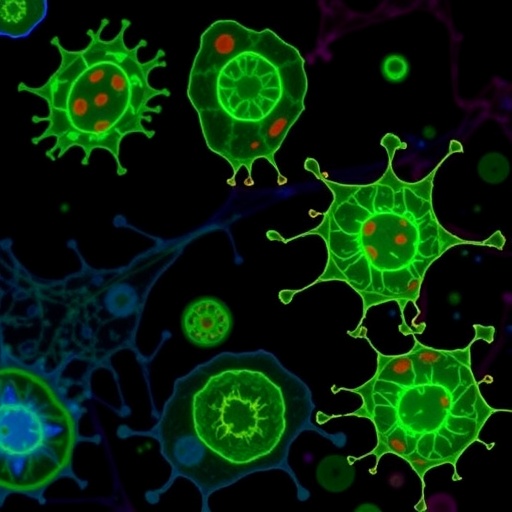In a groundbreaking multi-institutional study recently published in BMC Cancer, researchers have uncovered a significant prognostic factor in the recurrence of non-muscle invasive bladder cancer (NMIBC): prostate volume. This comprehensive analysis not only highlights the biological interplay between prostate size and bladder cancer recurrence but also revolutionizes predictive modeling in uro-oncology by incorporating prostate volume into advanced nomograms designed to forecast patient outcomes with unprecedented accuracy.
Non-muscle invasive bladder cancer, accounting for the majority of bladder cancer diagnoses, presents a clinical challenge due to its high rates of recurrence. Until now, predictive models have relied on traditional clinical and pathological factors, leaving room for enhanced precision. This study, involving a retrospective cohort of 555 patients from seven independent Chinese medical institutions, methodically investigates how prostate volume influences recurrence-free survival, introducing a novel dimension to risk stratification protocols.
Prostate volume was categorized into two distinct groups — patients with prostate volumes above and below 30 milliliters. The results were striking: those with larger prostate volumes exhibited significantly poorer 3-year recurrence-free survival rates compared to their counterparts with smaller prostates. This finding suggests a previously underappreciated role of the prostate microenvironment or associated anatomical changes in modulating bladder cancer behavior, warranting deeper exploration into the underlying pathophysiological mechanisms.
Central to the study was the development of two Cox regression-based nomograms — one integrating prostate volume and another excluding it. These models were constructed within a training cohort and subsequently validated externally, ensuring robustness and generalizability. The inclusion of prostate volume yielded superior predictive performance, demonstrated by a concordance index and area under the curve (AUC) metrics that consistently exceeded those of models omitting this variable across multiple time points.
Specifically, the 3-year AUC values for the prostate volume-inclusive model stood at 0.828 in the training dataset and 0.811 in the validation set, markedly outperforming the 0.796 and 0.778 figures for the volume-excluded models, respectively. Such improvements extend to the 1- and 2-year predictive horizons, cementing prostate volume as an indispensable biomarker in recurrence risk assessment. This precision enhancement promises to refine patient counseling and tailor surveillance strategies.
Moreover, decision curve analysis — a sophisticated method evaluating clinical utility — decisively favored the nomogram incorporating prostate volume. This indicates that incorporating this parameter into clinical algorithms could optimize decision-making, reducing unnecessary interventions while prioritizing high-risk patients for intensified surveillance or adjunct therapies.
The implications of this study transcend prognostication. They raise critical questions regarding the biological mechanisms linking prostate tissue characteristics to bladder cancer dynamics. Hypotheses under consideration include mechanical influences on bladder function, hormonal milieu alterations, or local immunological factors influenced by prostate hypertrophy, all of which merit further molecular and histopathological investigations.
From a clinical perspective, the integration of prostate volume assessment into routine NMIBC management could be seamless, given that imaging approaches such as transrectal ultrasound are already standard in urological practice. This facilitates rapid adoption of the nomogram into clinical workflows, potentially transforming the current paradigm that often struggles with under- or over-treatment.
This study also exemplifies the power of collaborative, multi-center research in oncology. By aggregating data from diverse hospitals, the results speak to a broad patient population, enhancing external validity. Additionally, the rigorous methodological framework — involving internal development and external validation — sets a gold standard for future prognostic tool development.
In summary, the discovery that prostate volume serves as a robust predictor of NMIBC recurrence, coupled with the creation of an advanced nomogram integrating this parameter, represents a significant leap forward in personalized oncologic care. It opens new avenues for targeted research and offers clinicians a more nuanced instrument for guiding patient management tailored to individual risk profiles.
Looking ahead, further investigations are needed to dissect the biological underpinnings of these findings, explore potential therapeutic implications, and assess the utility of such nomograms in different ethnic and demographic groups. This study lays a critical foundation for these explorations, signaling a paradigm shift in the intersection of urological anatomy and cancer prognostication.
The integration of prostate volume into recurrence prediction models epitomizes the evolving landscape of cancer prognostics — one that transcends conventional markers by embracing anatomical and physiological variables. This approach not only enriches our understanding of tumor-host interactions but also harnesses quantitative data to refine clinical outcomes.
For patients affected by NMIBC, the advent of such precise predictive models translates into more informed clinical decisions, better surveillance adherence, and potentially improved survival outcomes. The ability to stratify patients accurately enables healthcare providers to allocate resources efficiently, prioritize high-risk individuals, and potentially mitigate the psychosocial burden associated with cancer recurrence anxiety.
In conclusion, this illuminating study redefines how prostate volume influences NMIBC recurrence and offers a powerful, validated tool to enhance prognostic accuracy. As the oncology community strives for precision medicine, integrating such multifaceted parameters heralds a new era in cancer care — one where anatomy, pathology, and sophisticated analytics converge to optimize patient outcomes.
Subject of Research: Prognostic impact of prostate volume on recurrence risk in patients with non-muscle invasive bladder cancer (NMIBC) and development of predictive nomograms incorporating prostate volume.
Article Title: Prognostic value of prostate volume and nomograms for predicting recurrence in patients with non-muscle invasive bladder cancer: a multi-institutional study
Article References:
Hu, D., Liu, H., Li, M. et al. Prognostic value of prostate volume and nomograms for predicting recurrence in patients with non-muscle invasive bladder cancer: a multi-institutional study. BMC Cancer 25, 1719 (2025). https://doi.org/10.1186/s12885-025-15028-5
Image Credits: Scienmag.com
DOI: 05 November 2025
Tags: advanced nomograms for cancer predictionbladder cancer recurrence risk factorsclinical challenges in bladder cancer managementmulti-institutional cancer researchnon-muscle invasive bladder cancer prognosispredictive modeling in uro-oncologyprostate microenvironment and cancerprostate size and cancer outcomesprostate volume and bladder cancerrecurrence-free survival in bladder cancerretrospective cohort study on bladder cancerrisk stratification in uro-oncology





